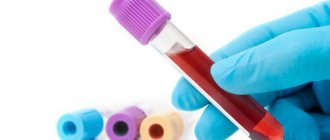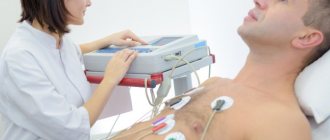In this article you will find information about what the normal heart rate is by age, in children, after physical and other activities.
The heart is a hollow muscular organ. It constantly contracts and relaxes, driving blood through the blood vessels. Thanks to this, all organs and tissues are saturated with nutrients and oxygen.
Pulse is one of the important indicators of heart condition. A normal heartbeat means that the heart is functioning well and without problems. In this article we will look at the normal pulse and blood pressure in adults and children at rest and after physical activity.
Tilts
Measure your resting pulse rate (heart rate - HR) while standing. Do 20 forward bends (when bending, exhale; when returning to the starting position, inhale) in one minute. Count your heart rate immediately after performing the test and after a minute of rest while standing. The pulse can be counted in ten seconds and multiplied by 6. So, you have three heart rate values - before the test, immediately after its completion and after a minute of rest. Add up all these values, subtract 200 from the resulting amount, and then divide by 10. Now let’s check our fitness level based on the results of a functional test:
- Indicator from 0 to 3 – your heart is in excellent condition
- From 3 to 6 is a good indicator
- 6-9 – average fitness
- 9-12 – low level of fitness
- The indicator is above 12 - you need to immediately consult a cardiologist and undergo a thorough examination.
What kind of doctor treats the heart and pulse?
Normal heart rate
The heart is an organ that continues its work throughout our lives. It is very important to keep him in good shape and avoid any complications with his work. Therefore, if there are any hints of problems with its operation, you should urgently contact a specialist.
- A cardiologist deals with the treatment and diagnosis of all aspects of the heart.
- If you experience any pain in this organ, you should immediately see this doctor to determine the root cause of the pathology.
If a person suffers from tachycardia (increased heart rate), then in this case, it is worth seeking a diagnosis not only from a cardiologist, but also from a therapist. In the future, you may need to consult with other doctors. It is the therapist who must give the referral. This list may include:
- Rheumatologist
- Endocrinologist
- Neurologist
- Psychotherapist
You should never delay going to the doctor. Such delays can lead to unpleasant outcomes, especially when it comes to the heart.
Remember: You should not self-diagnose or self-medicate heart disease. At the first signs of illness, it is better to immediately seek qualified help.
Walking up the stairs
Such a simple functional test as climbing stairs can be performed in any environment (especially if you live in a multi-story building).
- If you can quickly climb the stairs to the 5th-7th floor, stepping over two steps at once, and feel great, your body has a good margin of safety (and the pulse rate after the climb does not exceed 100 beats per minute)
- You step to the fifth floor, climbing step by step and having reached your goal, you do not experience noticeable shortness of breath or fatigue - your heart is quite well prepared for the stress (heart rate can rise to 120 beats/min)
- If the leisurely climb to the 5th floor has become a serious test for you (you are sweating, shortness of breath, palpitations) - you have a low level of fitness, your body is not prepared for possible stress (pulse 120-140 beats per minute)
- If you are unable to climb even to the second or third floor, immediately consult a doctor, because you need medical care and a long-term rehabilitation program to restore lost health.
Squat test
A simple and informative functional test is a load test with 20 squats (in case of deviations in health status, the test should be done in a medical facility). After a five-minute rest and measuring your resting heart rate, perform 20 squats for 20-30 seconds. The heart rate is re-recorded immediately after completion of the load. After a three-minute rest, another heart rate measurement is taken.
- If a person is well trained, the heart rate immediately after squats increases by 25-50% and returns to its original values in 1-3 minutes
- If your heart rate increases by 50-75% after squats and returns to normal after three minutes, your heart has good functional reserve
- If the heart rate after 20 squats increases by more than 75% and does not return to the original value after 3 minutes, in addition there is severe shortness of breath and palpitations - the safety margin of the cardiovascular system is minimal, further functional tests should be carried out only as prescribed by a cardiologist. At the same time, long-term systematic work remains to restore lost functional reserves.
Ruffier's test
- a) the subject is in a standing position for 5 minutes;
- b) pulse is calculated in 15 seconds (P1);
- c) after which physical activity of 30 squats per minute is performed;
- d) the pulse is re-calculated for the first 15 seconds (P2);
- e) the pulse is re-calculated for the last (P3) 15 seconds of the first minute of recovery.
When counting the pulse, the subject must stand. The calculated indicator of cardiac activity is a criterion for the optimal autonomic support of the cardiovascular system when performing low-power physical activity.
Heart performance is assessed using the formula: Ruffier index = (4 x (P1 + P2 + P3) - 200)/10
- if the cardiac activity indicator is less than 5, the test was performed “excellent”;
- if the indicator is less than 10, the test is performed “good”;
- if the indicator is less than 15 - “satisfactory”;
- if the indicator is more than 15 - “bad”.
In healthy subjects, the cardiac activity index does not exceed 12, and patients with neurocircular dystonia syndrome, as a rule, have a cardiac activity index of more than 15.
Normal blood pressure and heart rate by age in adults and children: table
Normal pulse
Usually, indicators of only an increased or decreased pulse are not regarded by a doctor as a separate pathology. Pressure is also always taken into account.
- If the pressure is normal, and the pulse indicators have slight deviations, then this is a patient’s condition that requires observation and sometimes treatment.
- If a rapid or infrequent pulse is accompanied by an increase or decrease in pressure, then it is worth assuming that the person has more serious pathologies associated with the heart and blood vessels.
Here are two tables with blood pressure and heart rate standards by age:
Normal pulse Normal pulse
At a young age, almost no one pays attention to blood pressure. But with age, when the vessels become less elastic, increased or decreased pressure becomes more noticeable. Therefore, after 40 years you need to start monitoring your pulse and blood pressure. Read more about this in the article on our website at this link .
Holding your breath
- Stange's test. After resting for five minutes, you need to take 2-3 deep breaths and exhale, then take another deep breath and hold your breath. The mouth and nose are tightly closed. The time during which breathing is possible is measured. Result: above 50 seconds - excellent, 40-50 - satisfactory, less than 40 - bad.
- Gench's functional test - holding your breath while exhaling. The study is performed similarly to the Stange test. Rating: delay above 40 seconds – good, 35-40 – satisfactory, less than 35 – bad.
In medical institutions, these tests can also be performed after physical activity (five squats).
6 Minute Walk Test
This is a stress test that allows you to assess physical performance and functionality of the cardiovascular system and respiratory organs. The 6-minute step test is usually used in patients with heart failure (CHF) who have suffered a myocardial infarction, severe pneumonia and tuberculosis, as well as in the elderly and senile. Can be performed both in a medical facility and at home.
When conducting a step test, the patient is given the task of walking as far as possible in 6 minutes along a measured (30 m) corridor marked at 1 m intervals, after which the distance traveled is recorded. Patients are allowed to stop and rest during the test; they should resume walking when deemed possible. While walking, you can encourage patients with standard phrases: for example, “Everything is going well,” “Continue at the same pace.” Before and at the end of the test, shortness of breath and pulse are assessed.
Distance traveled in 6 minutes (6MWD) is measured in meters and compared with the proper 6MWD (i). 6MWD (i) is calculated using the formulas below, which take into account age in years, body weight in kilograms, height in centimeters, body mass index (BMI).
- 6MWD (i) value for men: 7.57 x height in cm - 5.02 x age - 1.76 x body weight - 309; or 6MWD (i) = 1140 - 5.61 x BMI - 6.94 x age.
- 6MWD value for women: 2.11 x height in cm - 2.29 x weight - 5.78 x age + 667 or 6MWD (i) = 1017 - 6.24 x BMI - 5.83 x age.
For persons over 65 years of age, the proper distance of a 6-minute walk is determined according to the formulas of PL Enright (2003):
- for men: 493 + (2.2 height in cm) − (0.93 weight in kg) − (5.3 age) + 17;
- for women: 493 + (2.2 height in cm) − (0.93 weight in kg) − (5.3 age).
Normally, according to the 6-minute walk test, the subject must walk more than 551 meters. With I functional class CHF - 426-550 m, with II FC - 301-425 m, with III FC - 151-300 m, with IV FC - less than 150 meters.
At the age of 80 and with symptoms of frailty, the walking test can be made simpler - walk 6 meters in 8 seconds. If it is less, you need to adjust the doses of medications taken and carefully gradually optimize physical activity.
Orthostatic test
An available research method is the orthostatic test. When moving from a horizontal to a vertical position, the flow of blood to the right parts of the heart decreases, while the blood volume decreases by approximately 20%, and the minute volume decreases by 1–2.7 l/min. An increase in the tone of the sympathetic nervous system leads to increased heart rate and increased peripheral resistance. An orthostatic test allows you to assess tolerance to sudden changes in body position and determine autonomic reactivity.
The test is performed as follows. First you need to lie down and remain in a horizontal position for 15 minutes. After this, heart rate (HR) and blood pressure (BP) are measured. Then the subject stands up and after a minute the pulse and blood pressure are measured again. In healthy people, when performing the test, a decrease in systolic blood pressure by 5–10 mm Hg is observed. Art., and heart rate increases by an average of 17% from the original. Fitness can be assessed by changes in heart rate using the following indicators:
- A difference from 0 to 12 beats indicates good training.
- An increase in heart rate by 13-18 beats occurs in a healthy, but not trained person.
- An increase in heart rate from 18 to 25 beats indicates a lack of physical fitness.
- If the difference is more than 25 beats, then we can talk about either overwork, or a disease of the cardiovascular system or other health problems.
The functional tests listed above can be performed independently at home, which allows you to quickly determine the level of fitness of the cardiovascular and respiratory systems. If you have diseases of the heart, blood vessels, or other organs, it is necessary to conduct stress functional tests in a medical institution. Most often, this involves measuring pulse, blood pressure, respiratory rate, and recording an electrocardiogram (bicycle ergometry, treadmill test). If prescribed by a doctor, a functional test test such as stress echocardiography (ultrasound of the heart under load) can be performed to determine the functional state of the myocardium and identify hidden disorders of the blood supply to the heart muscle.
Signs of heart problems
Coronary heart disease can develop almost asymptomatically, occasionally causing shortness of breath. The coronary arteries supplying the myocardium narrow. Because of this, the supply of oxygen is reduced. At an advanced stage, this is a formidable pathology leading to disability or death. The number of people suffering from ischemic heart disease exceeds 120 million. Every year some of them die. Early diagnosis and timely treatment are the only way to stop the progression of the disease.
The first alarming symptoms appear when there is no heart pain yet:
- causeless swelling of the arms and legs;
- increased sweating;
- increased heart rate after moderate walking;
- periodically appearing weakness and dizziness.
The development of pathology is accompanied by regular arrhythmia, characteristic pressing pain behind the sternum, and difficulty breathing. At this stage, symptoms must be corrected by constantly taking medications. Therapy should be accompanied by a special diet and standardized physical activity.
Simple methods that identify disturbances in the blood supply and functioning of the heart muscle will help you not to be late in starting treatment. You can use them without leaving the entrance.










